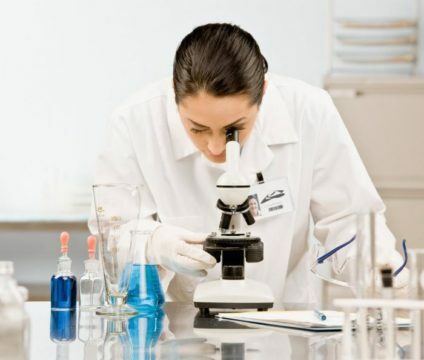When a woman is diagnosed with ovarian cysts, further treatment depends on the previous pathology of the causes, the nature and size of the neoplasm. In some cases, it is sufficient to take medications and regularly monitor the growth of the cyst. However, more often doctors send patients to the operation. The safest method that preserves the reproductive function of a woman is laparoscopy.

Safe solution of the
problem Laparoscopy is considered to be the most effective and safe operation, although as early as 10 years ago, women undergoing cysts underwent a normal cavitary operation, resulting in a longer recovery period and many complications. Despite the simplicity of the procedure, it is still a serious intervention in the body, so it is important to take a close look at all of its stages. Preparation for laparoscopy of the ovarian cyst includes:
- the delivery of urine and blood tests;
- biochemical analysis;
- a study on blood clotting;
- fluorography;
- examination of doctors, allowing to identify possible contraindications to the operation;
- electrocardiogram.
It is necessary to find out whether the cyst is malignant, since in this case the laparoscopic operation is unacceptable. Therefore, the preparation of the patient includes the delivery of tests for oncomarkers. Self-assessment of their results is better not to conduct, it can only do a doctor, comparing them with other indicators. Analyzes before laparoscopy, ovarian cysts are given up immediately before the manipulation, since out-dated results, obtained more than 3 months ago, are considered not informative.
Anesthesia with laparoscopy can be different - general, epidural, and spinal. The decision is made by an anesthesiologist, who takes into account the condition of the woman, as well as her wishes. The surgeon uses special tools - the patient is injected into the abdominal cavity with carbon dioxide, thus raising the walls of the abdomen. Next, the laparoscope itself is introduced, a tool similar to a pencil, at the end of which there is a camera that allows to examine the ovaries from all sides. Other punctures are used to introduce the trocar, with their help the found ovarian cyst is pierced. Having pumped out all the liquid, its shell is cut off. The surgeon's actions are visible on the monitor, where the video from the camera is output, which allows you to consider even those cysts that were not installed on ultrasound.
The manipulation can continue on average no more than 40-50 minutes, it all depends on the level of the doctor's qualifications, the size of the cyst and other individual characteristics.
Postoperative period
Recovery after laparoscopy of the ovarian cyst occurs quickly and without complications. The first few hours the woman continues to sleep after anesthesia. A slight chill is possible, so the patient is covered with a blanket. Pain sensations are minor, if necessary, you can take painkillers. Sometimes there is vomiting and dizziness, but you should not be afraid of this condition - it's a natural reaction of the body, you can suppress it with drugs that take these symptoms.

After 3-5 hours a woman can already go up and walk, although the first day after the operation she should spend in a hospital under the supervision of doctors. Recommended bed rest, helping to restore strength. After laparoscopy, ovarian cysts can not be taken, wait 5-6 hours, and preferably in the first day after the procedure, drink water.
Monthly after laparoscopy, ovarian cysts almost always begin after the procedure, correspondingly the usual menstrual cycle is lost. For this reason, many doctors try to make the day of the operation coincide with the end of the previous cycle. It is possible and on other days, the main thing is that on the day of the procedure there should be no monthly ones. Allocations after laparoscopy may differ from usual - be more abundant, long, others in color( brown) or, conversely, meager. In parallel, the puncture site may be affected. As a rule, from the next cycle, the monthly ones come back to normal.
Postoperative period after laparoscopy of the ovarian cyst lasts 2-3 weeks, so, despite the good state of health, do not at this time lift the weights, exercise yourself, have sex, take a bath and visit swimming pools and other open water. It is advisable to wear loose clothing that does not put pressure on the seams. Rehabilitation also involves adherence to dietary guidelines - it is necessary to exclude heavy food, carbonated drinks, and not overeat.
Problems in the postoperative period
Complications after laparoscopy Ovarian cysts are rare, but it is necessary to know about them. Since internal organs and tissues are not injured in this procedure, the taking of pain medication is not necessary. Treatment after laparoscopy, rather, has a preventive nature - a woman prescribed hormonal drugs, analgesics, sometimes antibiotics and antimicrobial agents. Medicines help to avoid the formation of adhesions, and with them problems in the future.
The temperature after laparoscopy of the ovarian cyst should not exceed normal limits. If its indicators are at the level of 38 and do not get lost, while a woman feels unwell, it is necessary to consult a doctor. Such symptoms may indicate internal bleeding or inflammation - it may have been affected by blood vessels or other organs.
Pain in the ovary after laparoscopy is possible, but it lasts no more than a day. The organ, one way or another, was damaged, it has an open wound, which causes pain. If they do not stop for several days, this is the reason for contacting a doctor.
Laparoscopy of the ovarian cyst implies a mandatory postoperative period, so the patient is given a sick leave sheet, which releases her from work for 7-10 days after discharge from the hospital. How long does the hospital in general? Everything depends on the situation, the woman's health, tests and complications. If desired, the patient can immediately start working, if her work is not connected with physical stress.
Histological examination of
 cysts The histology of the material obtained during the procedure is necessary to establish or exclude pathologies associated with oncology. This method of studying the tissues is unmistakable and the only one capable of determining whether a neoplasm was benign or malignant. The study is conducted within 10 days, but can be carried out urgently, when the situation requires it. The result is given in the hospital where the manipulation was performed.
cysts The histology of the material obtained during the procedure is necessary to establish or exclude pathologies associated with oncology. This method of studying the tissues is unmistakable and the only one capable of determining whether a neoplasm was benign or malignant. The study is conducted within 10 days, but can be carried out urgently, when the situation requires it. The result is given in the hospital where the manipulation was performed.
Pregnancy
It is possible to plan conception after surgery, however, the length of the interval between the performed procedure and the attempt to become pregnant depends on the initial diagnosis, the causes of the ovarian cyst, and the results of the histological tests. If the neoplasm was small, there were no infections in the woman, then conception is possible within a month, from the next cycle after laparoscopy.
In case such diagnoses as endometriosis, polycystosis and others were diagnosed, appropriate treatment should be performed before pregnancy. Otherwise, conception may not occur, or there will be difficulties with bearing. Obligatory monitoring of the doctor is necessary and in the process of planning pregnancy - often prescribed hormonal drugs to maintain the reproductive function of the female body.
The possibility of recurrence of the disease
In laparoscopic ovarian cysts, in rare cases, another occurrence of neoplasm is possible. Why is this happening? Most often the cause is a malfunction in the endocrine system of the patient, inflammation and infection. With endometriotic cysts, it is possible to correct the repeated growth of the cyst with the help of hormonal preparations. In other cases, no one will give an absolute guarantee. In order not to treat the cyst again or to remove it, it is necessary to visit the gynecologist every six months, do an ultrasound examination, monitor the diet and lead a healthy lifestyle. The hormonal background is too fragile and complex system of an organism, therefore any deviations from norms can lead to its infringement and occurrence of new illnesses.
In women who have reached climatic age, ovarian cysts can not only be formed after their removal, but also grow into malignant tumors. The only correct and necessary method in this situation is the removal of the cyst, and sometimes the ovary itself.
Laparoscopy of the ovarian cyst is by far the most sparing and reliable method of solving the problem. The responses of patients who underwent this procedure are mostly positive. After it, women quickly and easily recover, and most importantly, have every chance to become pregnant and endure a healthy baby. Undisputed advantage of such an operation is the safety of the reproductive function, and the only drawback is the long preparation for it - the delivery of tests and the passage of doctors takes time and patience. Of great importance in the effectiveness of the procedure is the positive attitude of the woman, during this period the support of relatives is important.



